This post may contain affiliate links. If you use these links to buy something we may earn a commission. Thanks.
If you have a small yard but still want to enjoy the benefits of shade, you’ll need a fast-growing tree with a dense canopy that inherently matures to a small size.
I’ve sat in plenty of small shady yards and remembered the most popular used trees for the purpose.
Japanese maples, Eastern redbuds, Crape Myrtles, Amur maples, Serviceberries, Kousa dogwoods, and Willows have varieties that make the best shade in small yards. Small cascading trees make for the most pleasing and cool outdoor environments.
Typical shade trees grow up to 100 or more feet, but the options in this list are friendly to small areas growing between 6-30 feet.
And not only will these trees offer shade, but beauty!
For each choice, you’ll learn about the growth rate, mature size, canopy density, foliage characteristics, conditions preferences, stress resilience, ornamental features, and maintenance requirements.
By the end, you’ll have a few great shade trees to decide between!
For larger shade trees, read: Fast-Growing Shade Trees (Best Picks & Why)
Disclaimer: Food Forest Living or its authors are not responsible for what you choose to consume. Do your own research before consuming as an “edible” or using any herb for medicine. Before planting any of these options check with your local invasive plant council or regional extension office for guidance on plants that may be invasive in your area.
Best Japanese Maples for Giving Shade in Small Yards
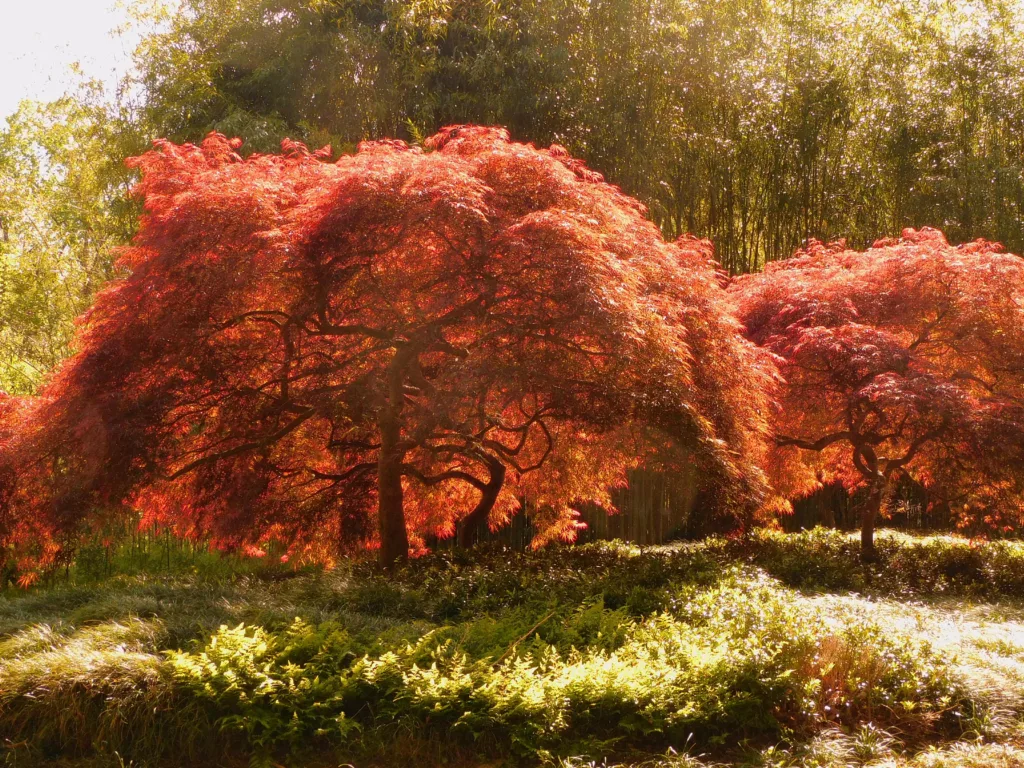
Japanese Maple trees (Acer palmatum) are graceful and elegant trees that give dappled shade.
You can choose between several varieties of Japanese Maples to find the right size and aesthetic for you and its new home.
In general, they grow at a moderate pace of 1-2 feet per year, mature between 6-25 feet, can have dappled to dense canopy coverage, offer various colors, are adaptable, have interesting branch habits, and are low maintenance.
Popular shade-giving varieties include Sango Kaku (Coral Bark Maple), Emperor I, Crimson Queen, and Bloodgood. Emperor I grows in zones 6-8, and the rest of 5-8.
Plenty more Japanese maple varieties exist, but here are the popular shade-giving ones and their differences:
| Type | Growth Rate | Mature size | Shade | Maintenance |
| Sango Kaku | Moderate | 15-25ft | Dappled | Low |
| Emperor I | Slow-Moderate | 15-20ft | Dense | Low |
| Crimson Queen | Slow | 6-8ft | Dense | Low |
| Bloodgood | Moderate | 15-20ft | Dense | Low |
Japanese maple trees are smaller than regular maples, so a moderate growth rate could be considered fast since it takes half the time to reach its mature height.
| Type | Preferences | Tolerance/sensitivity | Foliage | Features |
| Sango Kaku | Part/full sun, drained soil | Sensitive to heat | Green turns yellow in fall | Coral red bark |
| Emperor I | Part/full sun, drained soil | Sensitive to heat and wind | Glossy red/purple | Vibrant coloring |
| Crimson Queen | Part/full sun, drained soil | Sensitive to heat and wind | Deep red/purple | Cascading canopy |
| Bloodgood | Part/full sun, drained soil | Sensitive to heat and dryness | Deep burgundy turns bright red in fall | Classic maple structure |
Japanese maples are all sensitive to excessive heat, but proper mulching is one easy way to prevent heat stress in many plants.
See: 3 Keys To Correctly Mulch Any Tree (What To and Not Do)
Best Eastern Redbud for Giving Shade in Small Yards
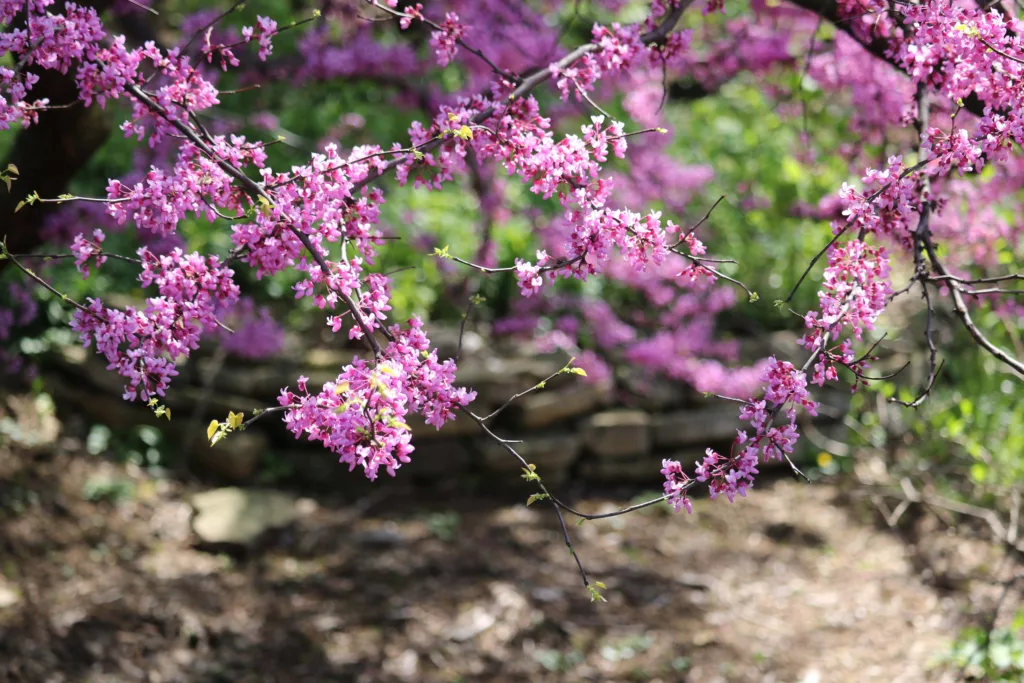
The Eastern Redbud (Cercis canadensis) trees are native to Eastern North America and are often chosen for their gorgeous pink or lavender fragrant spring blooms.
You can choose between several varieties of Eastern Redbud to find the right size, characteristics, and aesthetic for you and its permanent planting place.
In general, they grow at a moderate pace of 1-2 feet per year, mature between 15-30 feet, can have dappled to dense canopy coverage with various shapes, offer various colors, are resilient, have beautiful flowers, and are low maintenance.
Popular shade-giving varieties include Don Egolf, Rising Sun, and Forest Pansy. Each variety has a different level of hardiness, but Eastern Redbuds generally range from growing zones 4-9.
Plenty more varieties exist, but these are the popular shade-giving ones and their differences:
| Type | Growth Rate | Mature size | Shade | Maintenance |
| Don Egolf | Slow-Moderate | 15-20ft | Dense | Low |
| Rising Sun | Moderate | 20-25ft | Dappled | Low |
| Forest Pansy | Moderate | 20-30ft | Filtered/dappled | Low |
All are generally low maintenance. The maintenance you’ll need to stay on top of is removing dead wood and keeping it in a balanced shape if or when necessary.
See: 14 Best Chop and Drop Tools (+ When To Use What)
| Type | Preferences | Tolerance/sensitivity | Foliage | Features |
| Don Egolf | Part/full sun, drained soil | Sensitive to hot afternoon sun | Glossy green turns yellow in fall | Pink flowers, deep green leaves |
| Rising Sun | Part/full sun, drained soil | Sensitive to heat and wind | Gold leaves in spring, green in summer, to yellow in fall | Pink/purple flowers, complimentary coloring in spring |
| Forest Pansy | Part/full sun, various soils | Sensitive to heat and drought | Deep purple to bronze green to yellow/red | Pink spring flowers |
Zone 9 growers will need to protect them from excessive heat. Heat stress is less of an issue below zone 8.
Best Crape Myrtle for Giving Shade in Small Yards

Crape Myrtle (Lagerstroemia) trees are smaller and thrive in full sun so they are great for giving shade in hot places. People choose Crape Myrtles for their long-lasting and vibrant blooms, beautiful bark, small size, and resilience.
Choose between several varieties of Crape Myrtles all with differing shapes, colors, and heights.
In general, they grow at a fast pace of 2 or more feet per year, mature between 6-30 feet, offer dappled or dense canopies, have pollinator-friendly flowers, and are low maintenance.
Popular shade-giving varieties include Don Egolf, Rising Sun, and Forest Pansy. Each variety has a different level of hardiness, but Eastern Redbuds generally range from growing zones 4-9.
Plenty more varieties exist, but these are the popular shade-giving ones and their differences:
| Type | Growth Rate | Mature size | Shade | Maintenance |
| Natchez | Fast | 20-30ft H+W | Filtered/dappled | Low |
| Acoma | Moderate | 10-15ft H+W | Dappled | Low |
| Victor | Moderate | 10-12ft H+W | Dense | Low |
| Zuni | Moderate | 6-8ft H+W | Filtered/dappled | Low |
Crape myrtles lean on the fast-growing side and tend to grow as tall as they do wide.
| Type | Preferences | Tolerance/sensitivity | Foliage | Features |
| Natchez | Part/full sun, drained soil | Drought & heat tolerant | Dark green turns to orange/red | Upright canopy, white flowers |
| Acoma | Part/full sun, drained soil | Drought & heat tolerant | Bronze green to green to yellow/orange | Spreading canopy, white flowers |
| Victor | Part/full sun, drained soil | Drought & heat tolerant | Dark green turns to orange/red | Rounded canopy, deep red flowers |
| Zuni | Part/full sun, drained soil | Drought & heat tolerant | Dark green turns to orange/red | Upright canopy, lavender pink flowers |
Hot-dry weather doesn’t bother These resilient trees, but mulching is still recommended. Smaller trees benefit from suppressed weeds and retain moisture for smaller root systems.
While native to Asia, these trees have become naturalized in the USA. USA-native birds have found this tree a reliable and tasty food source.
Best Amur Maple for Giving Shade in Small Yards
Amur Maple (Acer ginnala) trees are grown for vibrant colors, small maturity, and quick growth. They provide dense shade from rounded compact growth—perfect for small yards.
Several varieties of Amur Maples offer more or less of your desired characteristics.
In general, they grow at a moderate pace of 1-2 feet per year, mature between 8-20 feet, and have low to moderate pruning maintenance.
Popular shade-giving varieties include Flame, Compact, and Ruby Slippers. Most Amur Maples grow in zones 3-8.
These are the popular shade-giving varieties and their differences:
| Type | Growth Rate | Mature size | Shade | Maintenance |
| Flame | Moderate | 15-20ft H+W | Dense | Low/medium |
| Compact | Slow-Moderate | 8-10ft H+W | Dense | Low/medium |
| Ruby Slippers | Moderate | 8-10ft H+W | Dense | Low/medium |
The canopies of amur maples are great for creating denser shade than Japanese Maples or Crape Myrtles. More pruning may be required to prevent rubbing branches and keep your tree free of dead limbs.
| Type | Preferences | Tolerance/sensitivity | Foliage | Features |
| Flame | Part/full sun, various soils | Tolerates drought & urban living | Medium size, green turns to red/orange/yellow | Dark grey, & orange fissured bark |
| Compact | Part/full sun, various soils | Tolerates drought & urban living | Small size, green turns to red/orange/yellow | Compact |
| Ruby Slippers | Part/full sun, various soils | Tolerates drought & urban living | Dark green turns to orange/red | Compact |
Amur maples can tolerate a wider range of soil types and dry conditions compared to Japanese Maples. Either one offers gorgeous coloring.
Best Serviceberries for Giving Shade in Small Yards
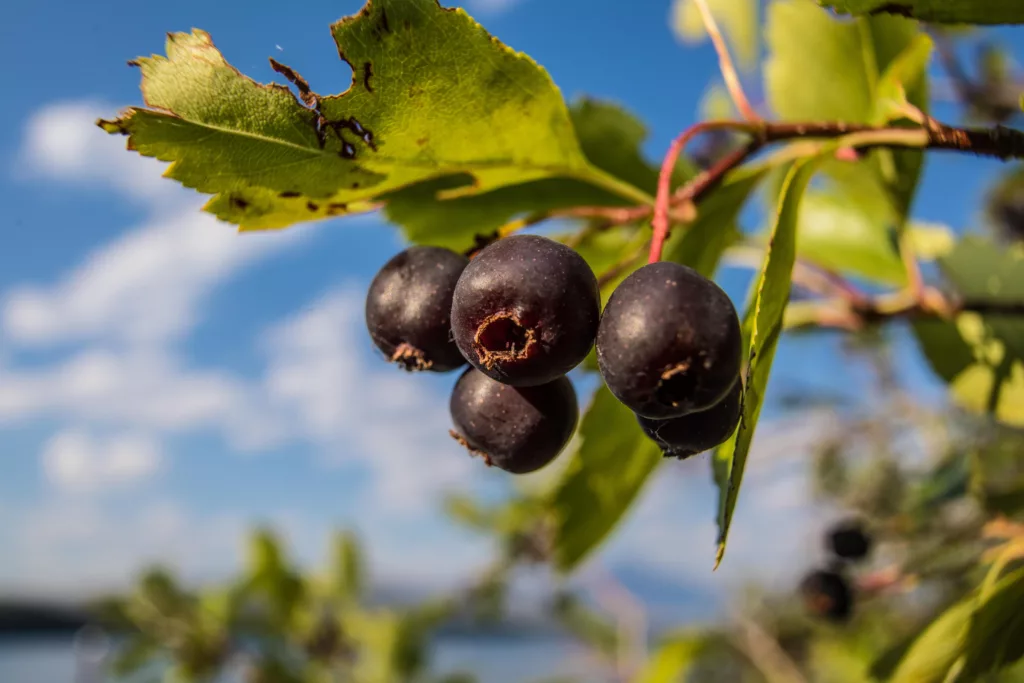
Serviceberries (Amelanchier) are often known as large fruiting shrubs, but they also come as small trees. White spring flowers turn into delicious and nutritious berries in summer, and the leaves in fall turn orange-red.
Several varieties of Serviceberry offer tasty fruit and dense shade, just choose the right height for you.
In general, they grow at a moderate pace of 1-2 feet per year, mature between 6-25 feet, and have low to moderate pruning maintenance.
Popular shade-giving varieties include:
- Regent Serviceberry (Amelanchier alnifolia ‘Regent’),
- Princess Diana Serviceberry (Amelanchier x grandiflora ‘Princess Diana’), and
- Autumn Brilliance Serviceberry (Amelanchier x grandiflora ‘Autumn Brilliance’).
Most Serviceberries grow in zones 4-8.
The tables below show different sizes and shapes of the best shade-giving varieties:
| Type | Growth Rate | Mature size | Shade | Maintenance |
| Regent | Moderate | 6-10ft H+W | Dense | Low/medium |
| Princess Diana | Moderate | 10-15ft H+W | Dense | Low/medium |
| Autumn Brilliance | Moderate | 15-25ft H+W | Dense | Low/medium |
Note the differences in height.
| Type | Preferences | Tolerance/sensitivity | Foliage | Features |
| Regent | Part/full sun, various soils | Tolerates drought, shade | Blue-green turns to orange-red, upright canopy | Flowers, dark purple berries, birds |
| Princess Diana | Part/full sun, various soils | Tolerates drought, shade | Green turns to orange-red, upright rounded canopy | Flowers, dark purple berries, birds |
| Autumn Brilliance | Part/full sun, various soils | Tolerates drought, shade | Green turns to orange-red, rounded canopy | Flowers, dark purple berries, birds |
Note the differences in foliage coloring and canopy shape.
Best Kousa Dogwood for Giving Shade in Small Yards
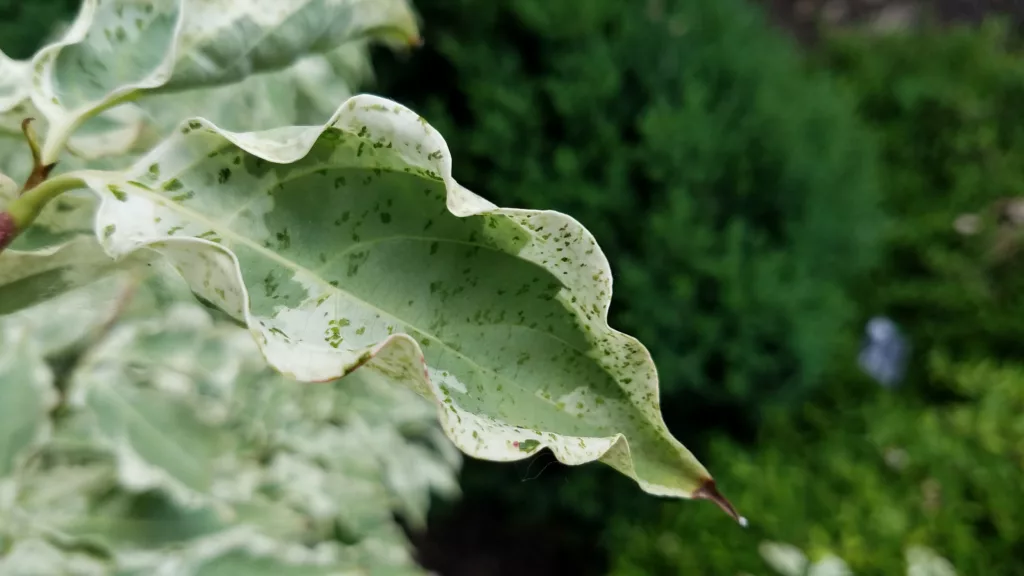
Kousa Dogwood (Cornus kousa) trees are known for their beauty from bark, flowers, to foliage and they offer a pleasant outdoor space with dappled shade.
Dogwoods mature to the perfect size for small yards. In general, however, they grow on the slower side of around 1 foot per year, so you’ll wait a while for your desired height compared to maples or willows.
The best shade-giving varieties mature between 10-20 feet in height and spread. They grow best in zones 5-8.
Popular shade-giving varieties include:
- Satomi
- Milky Way
- Wolf Eyes
- Summer Gold
Most Serviceberries grow in zones 4-8.
The tables below show different sizes and shapes of the best shade-giving varieties:
| Type | Growth Rate | Mature size | Shade | Maintenance |
| Satomi | Moderate | 15-20ft H+W | Dappled | Low/medium |
| Milky Way | Moderate | 15-20ft H+W | Dappled-dense | Low/medium |
| Wolf Eyes | Moderate | 10-15ft H+W | Dappled-dense | Low/medium |
| Summer Gold | Moderate | 10-15ft H+W | Dappled-dense | Low/medium |
These dogwoods are faster growing than most. They offer varying degrees of shade density and typically grow as high as they do wide.
| Type | Preferences | Tolerance/sensitivity | Foliage | Features |
| Satomi | Part/full sun, drainage | Tolerates drought, shade, urban living | Dark green turns red-purple | Rounded spreading canopy, large pink flowers |
| Milky Way | Part/full sun, drainage | Tolerates drought, shade, urban living | Dark green turns red-purple | Rounded dense canopy, white flowers |
| Wolf Eyes | Part/full sun, drainage | Tolerates drought, shade, urban living | Variegated green and white turns red-purple | Rounded compact canopy, Pink flowers |
| Summer Gold | Part/full sun, drainage | Tolerates drought, shade, urban living | Gold-yellow turns orange-red | Rounded canopy, yellow-white flowers |
All dogwoods have attractive bark and beautiful coloring in autumn. While known for loving moisture they tolerate dryness, perfect for a place that needs a bit of shade.
Best Willows for Giving Shade in Small Yards
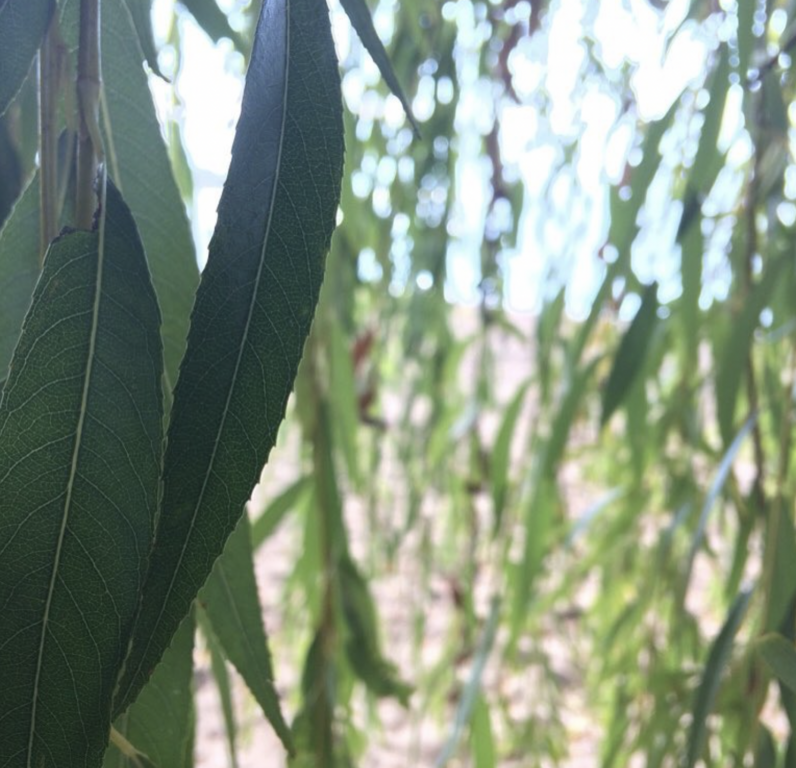
Willow trees are the fastest-growing cascading shade-giver on this list, but the struggle is finding a happy-medium size for small yards.
If you select a tree with a larger maturity size than suitable for your space, you’ll be in for overcrowding and more than otherwise necessary maintenance.
These willows grow at a fast rate between 1-8 feet per year. They grow best in zones 4-10
See the rate for each in the detailed breakdown:
| Type | Growth Rate | Mature size | Shade | Maintenance |
| Dwarf Willow | Moderate | 6-10ft H+W | Moderate | Low |
| Niobe Willow | Moderate | 15-20ft H, 10-15ft W | Moderate | Low |
| Arctic Willow | Fast | 3-6ft H+W | Dappled | Low |
These shorter willows are most suitable for small yards. The classic weeping willow grows up to 30-40 feet high and wide—too much for a “small yard.”
| Type | Preferences | Tolerance/sensitivity | Foliage | Features |
| Dwarf Willow | Full/part sun, adaptable | Tolerates water logging | Small & narrow | Compact growth |
| Niobe Willow | Part/full sun, adaptable | Tolerates waterlogging | Broad green silver | Upright growth |
| Arctic Willow | Full sun, adaptable | Tolerates cold and dryness | Silver green turns yellow | Attractive branches in winter |
Conclusion
The best tree for your yard is a combination of your preferences and the trees’ preferences or tolerances.
For an easy shade-giving tree, make your choice based on the preferences of the tree first, and your aesthetic preferences secondary.
Care for your new tree with proper mulching and watering to establish them quickly. Once established, consider adding edibles to your cool-shaded outdoor sitting area.
Up next: 24 Best Edible Ground Covers for Shade
Recent Posts
There’s no shortage of full-sun ground covers for zone 4 climates! Each plant in this list can withstand the frigid temperatures and also enjoy the hot sun in summer. Full sun means that a plant...
There's no shortage of full sun ground covers, not even in zone 3! Zone 3 climates offer hot but short-lived summers and very cold winters. So each plant in this list can withstand the frigid...

